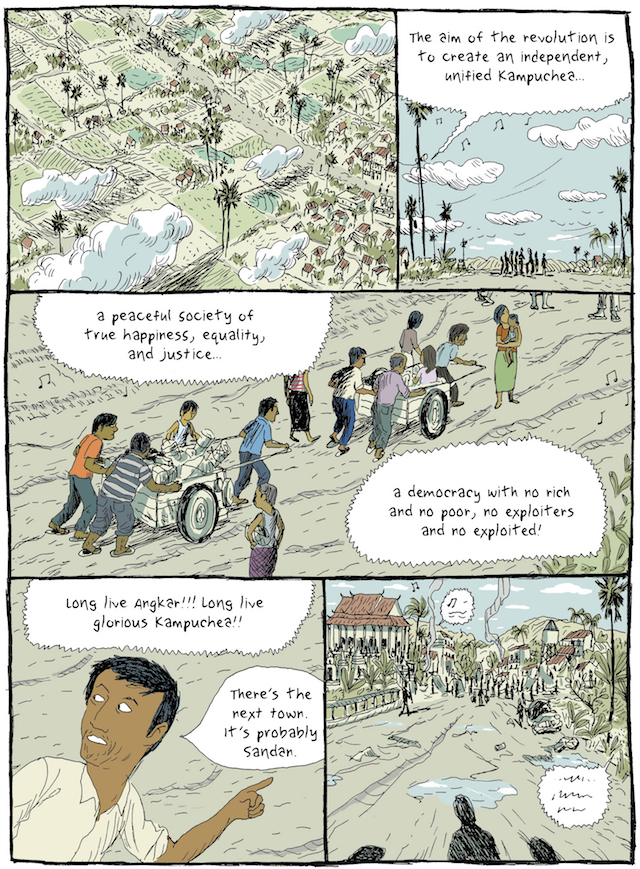Author and cartoonist Tian Veasna was born in 1975, three days after the fall of Phnom Penh, the Cambodian capital. His parents and the rest of his extended family were evacuated by the victorious Khmer Rouge amid rumors that the city was going to be bombed by American forces. As the new regime’s tanks roll into the city, his parents and extended family narrowly escape random checks by over-exuberant soldiers. Veasna’s family are members of the business and professional class—the sworn enemy of the Khmer Rouge, who are mainly peasant farmers. Outside the city, the family, like many others, has a route set out to leave the country. On their way, Khmer Rouge soldiers usher them aboard a boat to cross the lake. A family acquaintance steps in at the last moment and stops them. Veasna’s family later learns that every day the boat, loaded with bureaucrats and intellectuals, returns bloodstained and empty to port. Further on their route, the family is captured and taken to forced labor camps for re-education. Year of the Rabbit is the story of their treacherous journey.
Under the Khmer Rouge reign of terror some 2 million Cambodians, or 21% of the population, perished between 1975 and 1979. Minor transgressions often resulted in death. The Khmer Rouge lived by the principles of Angkar to transform the new republic into an agrarian power house. Under this bizarre re-education system, families were separated. The Khmer Rouge took charge of school age children to cultivate their revolutionary spirit and used them to spy on adults and report back. In one segment, a father is forced to his knees to apologize to his young son because the father had disciplined him. Under the new regime, children had the upper hand. Unmarried men and women were put to work on mobile brigades, while married couples toiled in rice paddies and farm fields in exchange for thin rice gruel. Seniors were required to look after young children, but enjoyed an extra serving of food.
The author and cartoonist should be commended for undertaking something as complex as Year of the Rabbit, with such apparent ease. One of the most interesting aspects of the book are the inserts at the beginning of each chapter, such as the maps of the family’s route out of Cambodia, which help to better situate the reader. There is also an insert on how to appear as a hidden enemy of Angkar, which includes hesitating when asked about your former job, appearing elegant or distinguished, criticizing Angkar’s methods or practising your religion. All of the inserts add important details that may have been overlooked by the reader or were difficult for the author to include in the storyline, but they add a wealth of engaging information.
 The cartoonist’s panels lack a certain depth, which is part of Veasna’s style. In addition to beautiful tropical-colored illustrations, the cartoonist serves up highly detailed art. In fact, there are so many details that readers might enjoy reading this book a second time just to make sure they haven’t missed anything. In my second reading, a lot of new information and details came to light, and I enjoyed the book even more.
The cartoonist’s panels lack a certain depth, which is part of Veasna’s style. In addition to beautiful tropical-colored illustrations, the cartoonist serves up highly detailed art. In fact, there are so many details that readers might enjoy reading this book a second time just to make sure they haven’t missed anything. In my second reading, a lot of new information and details came to light, and I enjoyed the book even more.
Veasna’s extended family includes nine aunts and uncles, grandparents and other in-laws. The efforts of the Khmer Rouge to destroy families wrought havoc on his family’s unity, which was their intention. Family members were separated into the various work brigades, sometimes miles away from one another, for long periods of time. Veasna doggedly chronicles their experiences and suffering at the hands of the Khmer Rouge. However, the author’s attempt at telling the stories of such a large cast is unwieldy at times, which results in some confusion as to the fate of some characters. But confusion has a place in this story, as it also typifies the highly chaotic reign of the Khmer Rouge.
 Although most readers will have heard of the horrors of Cambodian killing fields, Veasna gives us a much more personal view, a close-up of everyday family life, under the cruel and simple-minded Khmer Rouge. Veasna’s material comes from interviews with his surviving family members who today live in France, Switzerland and Canada. Even though they were reluctant to talk about their horrific past experiences in Cambodia and some could not bring themselves to read the book, the cartoonist and author has nevertheless created a heartrending, detailed story for future generations.
Although most readers will have heard of the horrors of Cambodian killing fields, Veasna gives us a much more personal view, a close-up of everyday family life, under the cruel and simple-minded Khmer Rouge. Veasna’s material comes from interviews with his surviving family members who today live in France, Switzerland and Canada. Even though they were reluctant to talk about their horrific past experiences in Cambodia and some could not bring themselves to read the book, the cartoonist and author has nevertheless created a heartrending, detailed story for future generations.







